
 |
|
|
|
Reaching further down into its vault of co-productions with England's Hammer Films, Ltd, Sony collects five mystery thrillers and one Science Fiction masterpiece under the title Icons of Suspense: Hammer Films. Hammer's Technicolor gothic horror films became legend but the company actually produced in a variety of genres. The color horrors often seem limited to tiny studio sets and a local park, but these B&W widescreen productions boast locations across England and even on the continent. Some of the titles in this collection are real rarities: most received only token releases in the United States and scant exhibition on Television. Several were severely cut for America, either for "mature themes" or just to render them as brief as possible for Columbia double bills. 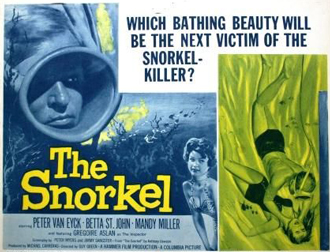
The collection begins with a murder thriller, 1958's The Snorkel. Written by Peter Myers and Hammer's in-house scribe Jimmy Sangster, Director Guy Green gets the most from the second gimmick, which is explained in the film's first scene. The killer seals himself into a gas-filled room, and breathes by donning an adapted diving snorkel mask. We know from the beginning that it's Paul Decker (Peter Van Eyck), a wife-killer who soon decides that his teenaged stepdaughter Candy (Mandy Miller) must die as well. Bizarre murders in a French setting remind us a bit of Clouzot's Les Diaboliques, while Candy's precocious investigation points forward to a number of sixties' chillers. Discounted as an unreliable witness, Candy must trap her stepfather on her own. Van Eyck is an undeveloped but menacing villain, and lovely Betta St.John offers good support as Candy's chaperone. Grégoire Aslan is the prerequisite French detective on the case. Mandy Miller's likeable teen heroine is a doubtful mix of immature emotions and steely resolve, as shown in one poorly handled scene when Candy underreacts to the death of her beloved dog. The film's good reputation comes from fans that admire the killer's technically elaborate murder scheme, and ace Hammer cameraman Jack Asher's arresting camerawork. A final surprise lifted from The Third Man could have provided a perfect shock finish, but the movie goes on a bit longer, clearly to tie up some moral loose ends for the censors. 1960's Stop Me Before I Kill! (known in England as The Full Treatment) is produced, co-written and directed by Val Guest, a superior filmmaker who made two of Hammer's best science fiction efforts. Despite locations in the South of France and excellent Megascope cinematography by Gil Taylor, the thriller is let down by an unusually weak script. Racing car driver Alan Colby (Ronald Lewis of Mr. Sardonicus) recovers from a wedding-day car crash but finds himself stricken with an illogical desire to strangle his wife Denise (Diane Cilento). Alan and Denise meet French psychiatrist David Prade (Claude Dauphin) on the Riviera. The charming aristocrat ignores Alan's unprovoked fits of temper and convinces him to submit to analysis. Meanwhile, Denise worries that another of Alan's violent episodes may be her last. The story and script by Ronald Scott Thorn is a tangle of bad psychiatry and painfully transparent mystery plotting. Top-billed Claude Dauphin's macabre chitchat about deadly spouses is clearly meant to upset Alan; the doctor follows the couple to London "just in case" his services might be needed. Alan's mood swings from sweetness to rage at least once in every scene in a way that's simply laughable. All of the film's important clues -- a Siamese cat, bruises on Denise's neck, a cable car in disrepair -- are clumsily foreshadowed. Alan even has a box of antique surgical instruments that seem awfully handy for a man with violent impulses. All three main actors do fine work under the circumstances and the location photography is splendid, but Stop Me Before I Kill! is definitely not Hammer's finest hour. Sony's encoding is an uncut English version, as it includes a brief glimpse of nudity in a swimming scene. 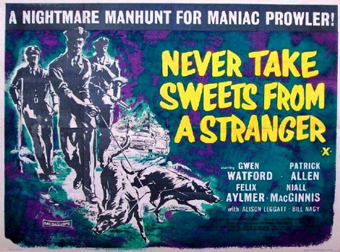
Never Take Candy from a Stranger (1960) sounds like trashy exploitation but is actually a responsible, thought-provoking movie about child molestation -- perhaps the best ever made on the subject. Director Cyril Frankel (On the Fiddle, The Devil's Own) does excellent work with John Hunter's adaptation of a play by Roger Garis. Sheltered eleven year-olds Lucille Demarest and Jean Carter (Estelle Brody & Janina Faye) tell their parents that the doddering Mr. Olderberry (Felix Aylmer) lured them into his house with candy and asked them to dance naked for him. Jean's parents, newcomers in their Canadian hamlet, find that the law is ineffective against the powerful Olderberry family, the founders of the town. The old man's wealthy son controls almost everything. The police are unhelpful and Mr. Demarest (Robert Arden of Mr. Arkadin) is entreated to declare his daughter unfit to testify. Olderberry's lawyer (Niall MacGinnis) traumatizes Jean on the witness stand. He implies that the Carters are perverted "outsiders" and threatens to force the girl to submit to psychiatric and physical tests. Freddie Francis's superior camerawork lends realism to all aspects of the story. Gwen Watford and Patrick Allen are excellent as Jean's caring parents and little Janina Faye (of Horror of Dracula and Day of the Triffids) is outstanding as the brave and innocent Jean. Felix Aylmer's senile Olderberry Sr. is disturbing, as we're accustomed to seeing the actor play figures of authority. By the end of the trial scene we've nearly forgotten that this is still a Hammer thriller, and when the two girls suddenly find themselves once again in jeopardy, the final reel of the picture is electrifying. Directed with taste and discretion, Never Take Candy from a Stranger comes to a chilling conclusion. In England the film was released as Never Take Sweets from a Stranger. It would make a thoughtful double bill with William Wyler's The Children's Hour, another problematic story in which children testify about a socially taboo subject. A compact and intense bank robbery tale, 1961's Cash on Demand provides Hammer stalwarts Peter Cushing and André Morell with a showcase for their acting talents. Adapted from a Television play, David T. Chantler and Lewis Greifer's script makes an asset of the film's single set. Director Quentin Lawrence broke out of TV only occasionally but acquits himself admirably. 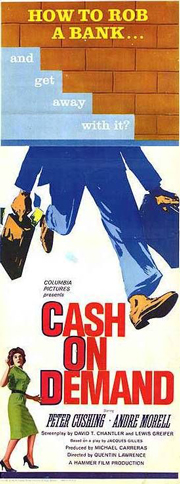
The focus is on Cushing's bank manager Fordyce, a veritable Ebenezer Scrooge who alienates his employees and browbeats his top clerks Pearson and Sanderson (Richard Vernon & Norman Bird) over inconsequential errors. That's when Bank Security Chief Hepburn (André Morell) shows up. The layout of the bank's rooms and vault (designed by Hammer's Bernard Robinson) becomes critical when Hepburn reveals to Fordyce that he's a bank robber, and that his confederates have already kidnapped Fordyce's wife and child. Forced to play along with Hepburn's scheme to loot the vault, the once-imperious Fordyce begins to crack up under the strain. Although fifty years of caper movies make a few of Cash on Demand's explanations and situations seem a little obvious now, its tension remains high. It's especially pleasant to see Peter Cushing given so much screen time to develop his character -- we're reminded of his breakout role in the BBC's landmark teleplay of 1984, where he carried the entire show. After Morell's robber beats him about the face, Cushing must take a few seconds to wipe the tears from his eyes. It's a marvelous little moment of acting. Cash on Demand is a real gem and a very welcome surprise. 1963's Maniac has excellent production values but labors under the weight of yet another gimmicky and obvious script by Jimmy Sangster. Hammer producer Michael Carreras directs this one with Sangster taking over producing responsibilities. In the interesting Camargue region of France, American artist Paul Farrell (Kerwin Mathews) parts company with his rich girlfriend, but finds warm companionship at the café of the two Beynat women. Paul romances the daughter Annette (Liliane Brousse of Paranoiac), only to be seduced by her mother Eve (Nadia Gray of La dolce vita). He then unwisely helps Eve spring her husband from an asylum for the criminally insane. It seems that Annette was raped five years before, and that Monsieur Beynat killed the offender with a blowtorch. One thing leads to another and Paul is soon helping Eve dispose of a corpse. Just when their problems seem resolved, Eve's mad husband reappears, seeking revenge. Sangster's wild plot reversals are too contrived to achieve the intended impact, while the dialogue repeatedly tips us off to what should be narrative surprises. Anybody familiar with TV whodunits knows that if a character's face isn't shown clearly, it's only a matter of time before some kind of identity switcheroo occurs. The acting is fine, especially that of Kerwin Mathews and Liliane Brousse. Ms. Gray struggles with the almost unplayable Eve, a woman who is both sincere and deceitful, often at the same time. The blowtorch and mutilation killings are mercifully kept off screen, but all credibility disappears when we are told that a bandaged patient has been burned beyond recognition -- we can see his untouched eyes and eyebrows, so why doesn't the suave Inspector Etienne (George Pastell) immediately recognize him? For that matter, why does the Inspector discount Paul's obvious participation in a prison break and a murder? 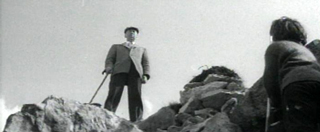
The final entry in the Icons of Suspense package is a categorical misfit. It's Joseph Losey's These are the Damned (1963; aka The Damned), one of the best and most profound science fiction films ever made. An angry expression of Ban-the-Bomb and anti-government secrets sentiment, Losey's film also has more to say about teenaged angst and societal alienation than Kubrick's somewhat similar A Clockwork Orange. The openly pessimistic story looks backward to Hammer's earlier Quatermass movies with their top-secret scientific projects, and forward to the growing "age of violence" that will soon permeate all levels of society. Completed in 1961, the film wasn't seen until 1963 in England and 1965 in the United States, and both releases were drastically edited. Sony's stunning Megascope transfer is the full original version, essentially seen nowhere until a few years ago. "Public servant" Bernard (Alexander Knox) presides over a secret project hidden in barren cliffs not far from the seaside town of Weymouth. Bernard's artist lover Freya (Viveca Lindfors) works in a stone house nearby, creating weird sculptures that look like people and animals charred by fire. A group of local "Teddy Boy" thugs led by the psychotic King (Oliver Reed) chases the disillusioned American Simon Wells (Macdonald Carey) and King's runaway sister Joan (Shirley Anne Field) to these same cliffs. Pursued by Bernard's security forces, Simon, Joan and King find themselves in a hidden bunker where live a strange group of girls and boys. The result of a nuclear accident, the mutated children are cold-blooded and radioactive: Bernard is raising them in isolation so that they will be prepared to live in the conditions that will prevail after the expected nuclear holocaust. The intruders attempt to free the young prisoners, not realizing that the children are lethal to normal, warm-blooded humans. Bernard can't contain his shocking secret, which fills Freya with both despair and fury: "Is that the extent of your dream, Bernard, to turn nine ice-cold children free in the ashes of the universe?" 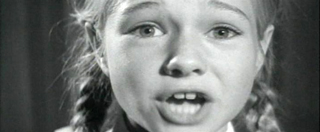
These are the Damned is world-class cinema that surely confused audiences expecting a biker saga or a replay of an earlier Sci-fi shocker about "deadly" children, Village of the Damned. Just prior to his discovery as a major art-film director, Joseph Losey finds a new form for a new anti-establishment genre. His disturbing story begins with a grating James Bernard rock song expressing the nihilism of the Teddy Boys ("Black Leather Black Leather Smash Smash Smash!"). The teen thugs parallel the equally irresponsible, death-worshipping military unit led by the haughtily paternalistic Bernard, who looks us straight in the eye and states unequivocally that nuclear annihilation is unavoidable. Details are everything, and These are the Damned produces a never-ending string of impressive images: the underground quarters of The Children, watched by closed-circuit TV; the machine-gun toting guards reminiscent of the possessed goons from Quatermass 2; the twin giant helicopters that pursue King's stolen sports car down a lonely beach road. The movie encounters acting difficulties with beautiful Shirley Anne Field, who nevertheless has a transcendant moment showing a frightened girl the beauty of the world outside her prison-cave. Losey's only real directorial stumble is his gross over-emphasis of Oliver Reed's incestuous desire for his sister. Macdonald Carey is convincing as a middle-aged American out of his element, but makes an uninspiring hero. Redeeming these problems is the stunning Viveca Lindfors, a Swedish actress foolishly discarded by Hollywood. Ms. Lindfors's life-affirming Freya is an indelible original. A maker of sculptures that also worship death, she becomes the muse for a mad bureaucrat who has learned to genuinely stop worrying and love the bomb. 
Joseph Losey's career is blessed with the kind of symmetry that film critics love. These are the Damned seems a thematic extension of elements in the director's first movie The Boy with Green Hair, another plea for human tolerance in the face of war. Green Hair's ghostly "war orphans" are very much like Damned's prepubescent guinea pigs, innocent victims lost in an insane world they didn't create. Both groups of children beg for help and understanding. A bona fide subversive classic, These are the Damned increases its grip on the audience as it speeds to one of the most doom-laden finishes in Science Fiction: "Help us! Help us! Please help us!" Sony's DVD set Icons of Suspense: Hammer Films contains six flawless enhanced B&W transfers with very clear audio; every film is encoded with English subtitles. The films all appear to be uncut English versions with American title substitutions. The Snorkel and These Are the Damned are substantially longer than their original American releases. Sony's keep case packaging stacks all three discs on a single hub, a controversial practice already given a thumbs-down by collectors concerned about scratches. All of the films come with American trailers. The various sales pitches fairly openly show us why the movies were not wildly popular. Never Take Candy from a Stranger comes off as sordid sensationalism. The Snorkel touts its gimmicky central plot device, and even uses the word "gimmick" in its voiceover script. The schizophrenic trailer for These are the Damned plays the outlandish "Black Leather" song over some of the film's most awkward moments. The 2007 premiere of These are the Damned on the TCM cable channel caused a minor sensation. Sony should have put the film out as a special edition but fans will be pleased to see it finally available in such a handsome presentation.
On a scale of Excellent, Good, Fair, and Poor,
Icons of Suspense: Hammer Films rates:
Footnote: 1. It's been assumed by many that because the story credit for The Snorkel was assigned to Anthony Dawson, it was written by Antonio Margheriti, the Italian filmmaker noted for taking that name on various movies, just as Riccardo Freda took the Anglicized name "Robert Hampton". This note from Christopher Koenig (April 5, 2010) appears to correct Savant's error, and straighten out the story: Hi Glenn. Thank you for getting back to me about The Snorkel in regards to the issue of Antonio Margheriti being responsible for the original story under the 'Anthony Dawson' name. I was able to get in touch with Edoardo Margheriti, son of Antonio, to find out if Antonio did write that story. Edoardo has a website devoted to his father at this link. On the filmography page there is no listing for Margheriti writing the story for The Snorkel. Edoardo e-mailed me back and this is what he had to say... Hi Chris, I believe you are right, the story was probably written by Anthony Dawson (the actor) and not my father... especially because he used for the first time in 1960 (Space Men - Assignment: Outer Space) the nickname Anthony Daisies. (note: in Italian, Margherite = Daisies.) After that film the American distributors, due to the funny sound the name had in English they suggested the name Dawson and my father agreed. This was happening in 1961, so it's not possible that he was using Dawson before that date. Ciao, was nice writing to you. Edoardo Margheriti
So, it is very likely that the British actor Anthony Dawson did write the original story and not Margheriti. In addition, the IMDB lists actor Dawson as a writer on a TV series called Ghost Squad, however what particular episodes he's written haven't been confirmed. Thanks for reading and I hope to hear back from you soon. Chris Koenig
Reviews on the Savant main site have additional credits information and are often updated and annotated with reader input and graphics. Also, don't forget the 2010 Savant Wish List. T'was Ever Thus.
Review Staff | About DVD Talk | Newsletter Subscribe | Join DVD Talk Forum |
| ||||||||||||||||||